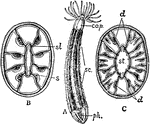Clipart tagged: ‘exoskeleton’

Armadillo - Endoskeleton and Exoskeleton or Dermoskeleton
An illustration of a pichiciago, a small burrowing armadillo. The front half of the animal is covered…

Crab
This illustration shows a crab, a species of cancer. Crabs are decapod crustaceans with thick exoskeletons.

Insect Crust
Section through insect crust, showing layers of chitin at c, the cellular layer or hypodermis…

Shackle Joint from the Exoskeleton of a Siluroid Fish
"A joint involving the principle of the shackle. Specifically, in anatomy, a kind of articulation found…

Zooid
"Single zooid with the adjacent soft tissues as seen after removal of the exoskeleton by decalcification.…